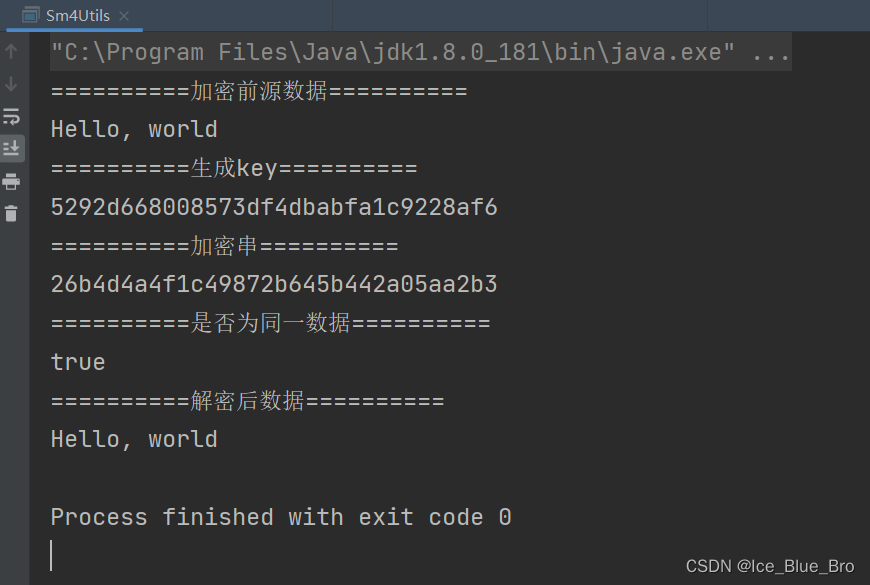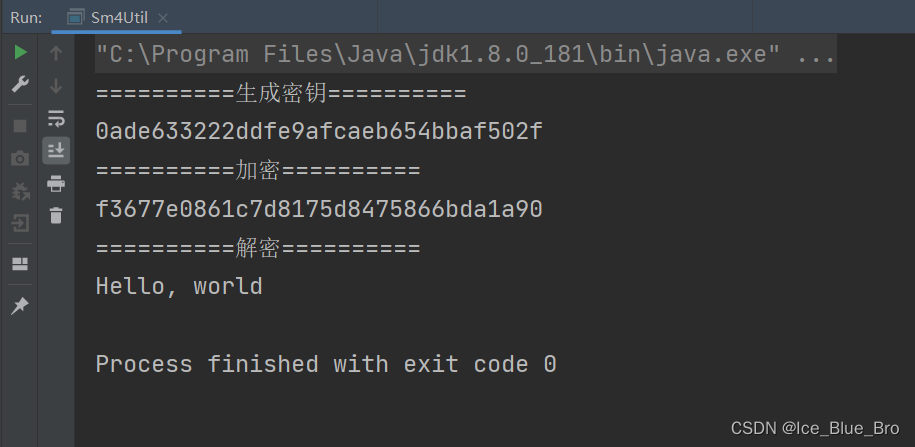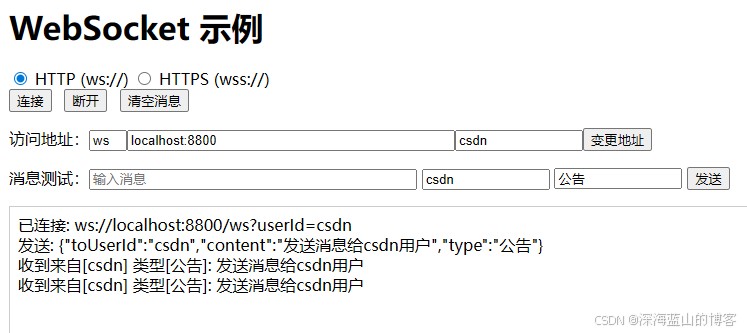国产SM4加密解密算法概念
SMS4算法是在国内广泛使用的WAPI无线网络标准中使用的加密算法,是一种32轮的迭代非平衡Feistel结构的分组加密算法,其密钥长度和分组长度均为128。SMS4算法的加解密过程中使用的算法是完全相同的,唯一不同点在于该算法的解密密钥是由它的加密密钥进行逆序变换后得到的。
SMS4分组加密算法是中国无线标准中使用的分组加密算法,在2012年已经被国家商用密码管理局确定为国家密码行业标准,标准编号GM/T 0002-2012并且改名为SM4算法,与SM2椭圆曲线公钥密码算法,SM3密码杂凑算法共同作为国家密码的行业标准,在我国密码行业中有着极其重要的位置。
SMS4算法的分组长度为128bit,密钥长度也是128bit。加解密算法均采用32轮非平衡Feistel迭代结构,该结构最先出现在分组密码LOKI的密钥扩展算法中。
SMS4通过32轮非线性迭代后加上一个反序变换,这样只需要解密密钥是加密密钥的逆序,就能使得解密算法与加密算法保持一致。SMS4加解密算法的结构完全相同,只是在使用轮密钥时解密密钥是加密密钥的逆序。
S盒是一种利用非线性变换构造的分组密码的一个组件,主要是为了实现分组密码过程中的混淆的特性和设计的。SMS4算法中的S盒在设计之初完全按照欧美分组密码的设计标准进行,它采用的方法是能够很好抵抗差值攻击的仿射函数逆映射复合法。
1.SM4/ECB/PKCS5Padding
实现代码
|
1 2 3 4 5 6 7 8 9 10 11 12 13 14 15 16 17 18 19 20 21 22 23 24 25 26 27 28 29 30 31 32 33 34 35 36 37 38 39 40 41 42 43 44 45 46 47 48 49 50 51 52 53 54 55 56 57 58 59 60 61 62 63 64 65 66 67 68 69 70 71 72 73 74 75 76 77 78 79 80 81 82 83 84 85 86 87 88 89 90 91 92 93 94 95 96 97 98 99 100 101 102 103 104 105 106 107 108 109 110 111 112 113 114 115 116 117 118 119 120 121 122 123 124 125 126 127 128 129 130 131 132 133 134 135 136 137 138 139 140 141 142 143 144 145 146 147 148 149 150 151 152 153 154 155 156 157 158 159 160 161 162 163 164 165 166 167 168 169 170 171 172 173 174 175 176 177 178 179 180 181 182 183 184 185 186 187 188 189 190 191 192 193 194 195 196 197 198 199 200 |
import org.bouncycastle.jce.provider.BouncyCastleProvider; import org.bouncycastle.pqc.math.linearalgebra.ByteUtils; import org.bouncycastle.util.encoders.Hex;
import javax.crypto.Cipher; import javax.crypto.KeyGenerator; import javax.crypto.spec.SecretKeySpec; import java.security.Key; import java.security.SecureRandom; import java.security.Security; import java.util.Arrays;
/** * Sm4 国密算法 * */ public final class Sm4Utils {
static { Security.addProvider(new BouncyCastleProvider()); }
private static final String ENCODING = "UTF-8"; public static final String ALGORITHM_NAME = "SM4"; // 加密算法/分组加密模式/分组填充方式 // PKCS5Padding-以8个字节为一组进行分组加密 // 定义分组加密模式使用:PKCS5Padding public static final String ALGORITHM_NAME_ECB_PADDING = "SM4/ECB/PKCS5Padding"; // 128-32位16进制;256-64位16进制 public static final int DEFAULT_KEY_SIZE = 128;
/** * 自动生成密钥 * * @return * @explain */ public static String generateKey() throws Exception { return new String(Hex.encode(generateKey(DEFAULT_KEY_SIZE))); }
/** * @param keySize * @return * @throws Exception * @explain */ public static byte[] generateKey(int keySize) throws Exception { KeyGenerator kg = KeyGenerator.getInstance(ALGORITHM_NAME, BouncyCastleProvider.PROVIDER_NAME); kg.init(keySize, new SecureRandom()); return kg.generateKey().getEncoded(); }
/** * 生成ECB暗号 * * @param algorithmName 算法名称 * @param mode 模式 * @param key * @return * @throws Exception * @explain ECB模式(电子密码本模式:Electronic codebook) */ private static Cipher generateEcbCipher(String algorithmName, int mode, byte[] key) throws Exception { Cipher cipher = Cipher.getInstance(algorithmName, BouncyCastleProvider.PROVIDER_NAME); Key sm4Key = new SecretKeySpec(key, ALGORITHM_NAME); cipher.init(mode, sm4Key); return cipher; }
/** * sm4加密 * * @param hexKey 16进制密钥(忽略大小写) * @param paramStr 待加密字符串 * @return 返回16进制的加密字符串 * @explain 加密模式:ECB * 密文长度不固定,会随着被加密字符串长度的变化而变化 */ public static String encryptEcb(String hexKey, String paramStr) { try { String cipherText = ""; // 16进制字符串-->byte[] byte[] keyData = ByteUtils.fromHexString(hexKey); // String-->byte[] byte[] srcData = paramStr.getBytes(ENCODING); // 加密后的数组 byte[] cipherArray = encryptEcbPadding(keyData, srcData); // byte[]-->hexString cipherText = ByteUtils.toHexString(cipherArray); return cipherText; } catch (Exception e) { return paramStr; } }
/** * 加密模式之Ecb * * @param key * @param data * @return * @throws Exception * @explain */ public static byte[] encryptEcbPadding(byte[] key, byte[] data) throws Exception { Cipher cipher = generateEcbCipher(ALGORITHM_NAME_ECB_PADDING, Cipher.ENCRYPT_MODE, key); return cipher.doFinal(data); }
/** * sm4解密 * * @param hexKey 16进制密钥 * @param cipherText 16进制的加密字符串(忽略大小写) * @return 解密后的字符串 * @throws Exception * @explain 解密模式:采用ECB */ public static String decryptEcb(String hexKey, String cipherText) { // 用于接收解密后的字符串 String decryptStr = ""; // hexString-->byte[] byte[] keyData = ByteUtils.fromHexString(hexKey); // hexString-->byte[] byte[] cipherData = ByteUtils.fromHexString(cipherText); // 解密 byte[] srcData = new byte[0]; try { srcData = decryptEcbPadding(keyData, cipherData); // byte[]-->String decryptStr = new String(srcData, ENCODING); } catch (Exception e) { e.printStackTrace(); } return decryptStr; }
/** * 解密 * * @param key * @param cipherText * @return * @throws Exception * @explain */ public static byte[] decryptEcbPadding(byte[] key, byte[] cipherText) throws Exception { Cipher cipher = generateEcbCipher(ALGORITHM_NAME_ECB_PADDING, Cipher.DECRYPT_MODE, key); return cipher.doFinal(cipherText); }
/** * 校验加密前后的字符串是否为同一数据 * * @param hexKey 16进制密钥(忽略大小写) * @param cipherText 16进制加密后的字符串 * @param paramStr 加密前的字符串 * @return 是否为同一数据 * @throws Exception * @explain */ public static boolean verifyEcb(String hexKey, String cipherText, String paramStr) throws Exception { // 用于接收校验结果 boolean flag = false; // hexString-->byte[] byte[] keyData = ByteUtils.fromHexString(hexKey); // 将16进制字符串转换成数组 byte[] cipherData = ByteUtils.fromHexString(cipherText); // 解密 byte[] decryptData = decryptEcbPadding(keyData, cipherData); // 将原字符串转换成byte[] byte[] srcData = paramStr.getBytes(ENCODING); // 判断2个数组是否一致 flag = Arrays.equals(decryptData, srcData); return flag; }
public static void main(String[] args) { try { String paramStr = "Hello, world"; System.out.println("==========加密前源数据=========="); System.out.println(paramStr); // 生成32位16进制密钥 String key = Sm4Utils.generateKey(); System.out.println("==========生成key=========="); System.out.println(key); String cipher = Sm4Utils.encryptEcb(key, paramStr); System.out.println("==========加密串=========="); System.out.println(cipher); System.out.println("==========是否为同一数据=========="); System.out.println(Sm4Utils.verifyEcb(key, cipher, paramStr)); paramStr = Sm4Utils.decryptEcb(key, cipher); System.out.println("==========解密后数据=========="); System.out.println(paramStr); } catch (Exception e) { e.printStackTrace(); } } } |
结果如下:

2.SM4/CBC/PKCS5Padding
示例代码
|
1 2 3 4 5 |
<dependency> <groupId>org.bouncycastle</groupId> <artifactId>bcprov-jdk15to18</artifactId> <version>1.68</version> </dependency> |
|
1 2 3 4 5 6 7 8 9 10 11 12 13 14 15 16 17 18 19 20 21 22 23 24 25 26 27 28 29 30 31 32 33 34 35 36 37 38 39 40 41 42 43 44 45 46 47 48 49 50 51 52 53 54 55 56 57 58 59 60 61 62 63 64 65 66 67 68 69 70 71 72 73 74 75 76 77 78 79 80 81 82 83 84 85 86 87 88 89 90 91 92 93 94 95 96 97 98 99 100 101 102 103 104 105 106 107 108 109 110 111 112 113 114 115 116 117 118 119 120 121 122 123 124 125 126 127 128 129 130 131 132 133 134 135 136 137 138 139 140 141 142 143 144 145 146 147 148 149 150 151 152 153 154 155 156 157 158 159 160 161 162 163 164 165 166 167 168 169 170 171 172 173 174 175 176 177 178 179 180 181 182 183 |
import org.bouncycastle.jce.provider.BouncyCastleProvider; import org.bouncycastle.pqc.math.linearalgebra.ByteUtils;
import javax.crypto.Cipher; import javax.crypto.KeyGenerator; import javax.crypto.spec.IvParameterSpec; import javax.crypto.spec.SecretKeySpec; import java.security.AlgorithmParameters; import java.security.Key; import java.security.SecureRandom; import java.security.Security; import java.util.Arrays;
/** * Sm4 国密算法 * */ public final class Sm4Util {
static { Security.addProvider(new BouncyCastleProvider()); }
private static final String ENCODING = "UTF-8";
public static final String ALGORITHM_NAME = "SM4"; // 加密算法/分组加密模式/分组填充方式 // PKCS5Padding-以8个字节为一组进行分组加密 // 定义分组加密模式使用:PKCS5Padding
public static final String ALGORITHM_NAME_CBC_PADDING = "SM4/CBC/PKCS5Padding"; // 128-32位16进制;256-64位16进制 public static final int DEFAULT_KEY_SIZE = 128;
/** * 自动生成密钥 * * @return * @explain */ public static byte[] generateKey() throws Exception { return generateKey(DEFAULT_KEY_SIZE); }
/** * 自动生成密钥 * @return * @throws Exception */ public static String generateKeyString() throws Exception { return ByteUtils.toHexString(generateKey()); }
/** * @param keySize * @return * @throws Exception * @explain */ public static byte[] generateKey(int keySize) throws Exception { KeyGenerator kg = KeyGenerator.getInstance(ALGORITHM_NAME, BouncyCastleProvider.PROVIDER_NAME); kg.init(keySize, new SecureRandom()); return kg.generateKey().getEncoded(); }
/** * sm4加密 * * @param hexKey 16进制密钥(忽略大小写) * @param paramStr 待加密字符串 * @return 返回16进制的加密字符串 * @throws Exception * @explain 加密模式:CBC */ public static String encrypt(String hexKey, String paramStr) throws Exception { String result = ""; // 16进制字符串-->byte[] byte[] keyData = ByteUtils.fromHexString(hexKey); // String-->byte[] byte[] srcData = paramStr.getBytes(ENCODING); // 加密后的数组 byte[] cipherArray = encryptCbcPadding(keyData, srcData);
// byte[]-->hexString result = ByteUtils.toHexString(cipherArray); return result; }
/** * 加密模式之CBC * * @param key * @param data * @return * @throws Exception * @explain */ public static byte[] encryptCbcPadding(byte[] key, byte[] data) throws Exception { Cipher cipher = generateCbcCipher(ALGORITHM_NAME_CBC_PADDING, Cipher.ENCRYPT_MODE, key); return cipher.doFinal(data); }
/** * 加密模式之CBC * @param algorithmName * @param mode * @param key * @return * @throws Exception */ private static Cipher generateCbcCipher(String algorithmName, int mode, byte[] key) throws Exception { Cipher cipher = Cipher.getInstance(algorithmName, BouncyCastleProvider.PROVIDER_NAME); Key sm4Key = new SecretKeySpec(key, ALGORITHM_NAME); cipher.init(mode, sm4Key, generateIV()); return cipher; }
/** * 生成iv * @return * @throws Exception */ public static AlgorithmParameters generateIV() throws Exception { //iv 为一个 16 字节的数组,这里采用和 iOS 端一样的构造方法,数据全为0 byte[] iv = new byte[16]; Arrays.fill(iv, (byte) 0x00); AlgorithmParameters params = AlgorithmParameters.getInstance(ALGORITHM_NAME); params.init(new IvParameterSpec(iv)); return params; }
/** * sm4解密 * * @param hexKey 16进制密钥 * @param text 16进制的加密字符串(忽略大小写) * @return 解密后的字符串 * @throws Exception * @explain 解密模式:采用CBC */ public static String decrypt(String hexKey, String text) throws Exception { // 用于接收解密后的字符串 String result = ""; // hexString-->byte[] byte[] keyData = ByteUtils.fromHexString(hexKey); // hexString-->byte[] byte[] resultData = ByteUtils.fromHexString(text); // 解密 byte[] srcData = decryptCbcPadding(keyData, resultData); // byte[]-->String result = new String(srcData, ENCODING); return result; }
/** * 解密 * * @param key * @param cipherText * @return * @throws Exception * @explain */ public static byte[] decryptCbcPadding(byte[] key, byte[] cipherText) throws Exception { Cipher cipher = generateCbcCipher(ALGORITHM_NAME_CBC_PADDING, Cipher.DECRYPT_MODE, key); return cipher.doFinal(cipherText); }
public static void main(String[] args) throws Exception {
String str = "Hello, world" ; System.out.println("==========生成密钥=========="); String generateKey = generateKeyString(); System.out.println(generateKey); System.out.println("==========加密=========="); String encrypt = encrypt(generateKey, str); System.out.println(encrypt); System.out.println("==========解密=========="); String decrypt = decrypt(generateKey, encrypt); System.out.println(decrypt); } } |
结果如下


